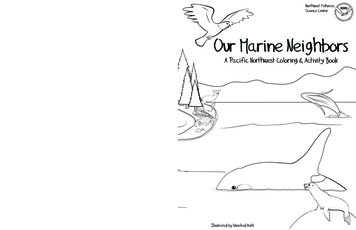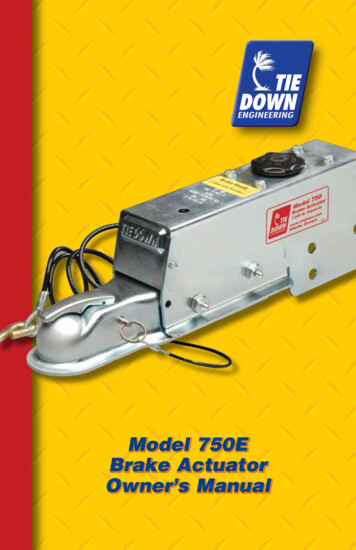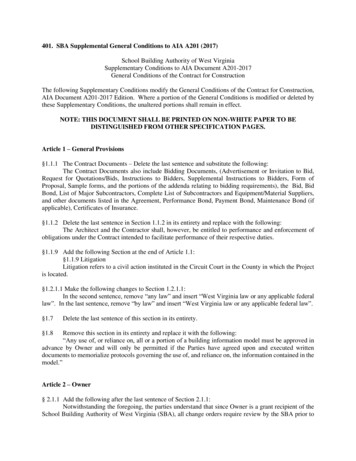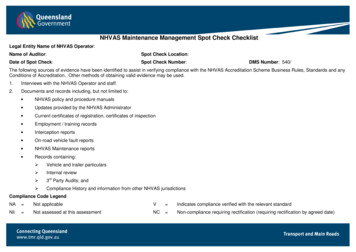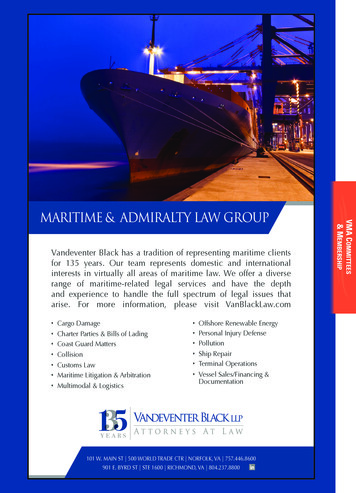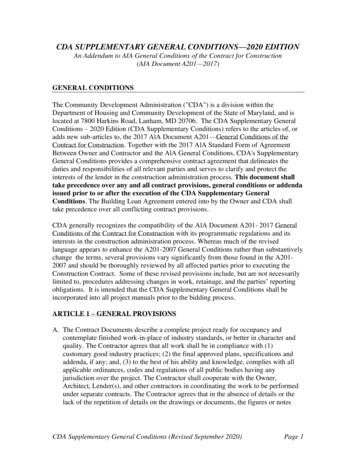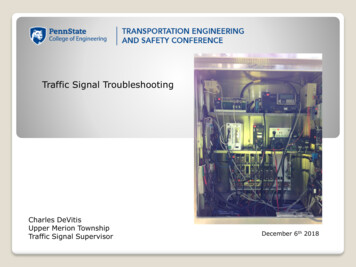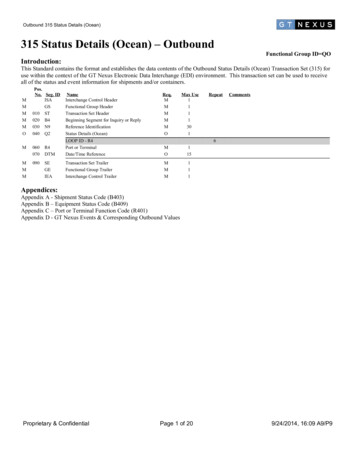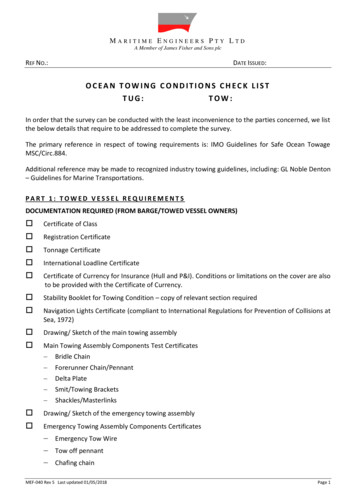
Transcription
MARITIME ENGINEERS PTY LTDA Member of James Fisher and Sons plcREF NO.:DATE ISSUED:OCEAN TOWING CONDITIONS CHECK LISTTUG:TOW:In order that the survey can be conducted with the least inconvenience to the parties concerned, we listthe below details that require to be addressed to complete the survey.The primary reference in respect of towing requirements is: IMO Guidelines for Safe Ocean TowageMSC/Circ.884.Additional reference may be made to recognized industry towing guidelines, including: GL Noble Denton– Guidelines for Marine Transportations.PART 1: TOWED VESSEL REQUIREMENTSDOCUMENTATION REQUIRED (FROM BARGE/TOWED VESSEL OWNERS) Certificate of Class Registration Certificate Tonnage Certificate International Loadline Certificate Certificate of Currency for Insurance (Hull and P&I). Conditions or limitations on the cover are alsoto be provided with the Certificate of Currency. Stability Booklet for Towing Condition – copy of relevant section required Navigation Lights Certificate (compliant to International Regulations for Prevention of Collisions atSea, 1972) Drawing/ Sketch of the main towing assembly Main Towing Assembly Components Test Certificates Bridle Chain Forerunner Chain/Pennant Delta Plate Smit/Towing Brackets Shackles/Masterlinks Drawing/ Sketch of the emergency towing assembly Emergency Towing Assembly Components Certificates Emergency Tow Wire Tow off pennant Chafing chainMEF-040 Rev S Last updated 01/05/2018Page 1
MARITIME ENGINEERS PTY LTDA Member of James Fisher and Sons plcREF NO.:DATE ISSUED: Shackles Emergency Smit/towing bracketCONDITIONS: No slack tanks Main towing bridle to be studlink chain led forward through heavy duty fairleads and made fast totwo sets of Smit type towing brackets and connected to delta plate at outer end. A chainforerunner is to be connected to the delta plate and suitable to accept the main tow wire shackle.(Do not remove studs to accommodate shackles). In some circumstances composite chain and wire bridles may be accepted. Protection againstchafing to be provided at fairleads. A powered bridle recovery winch shall be provided capable of lifting the bridle and forerunnerclear of the barge keel line. Emergency tow wire to be led from a Smit bracket and fairlead midships at the bow with anappropriate length of chafing chain to the wire which shall be becketed along port or starboardside of tow with tow off pennant flaked out aft and becketed down (alternative to the tow offpennant is a tow off wire “dartboard” type cassette). Buoyed pick-up line to be trailed (torpedo type buoy preferred). Fixed boarding ladders to be provided port and starboard (for high freeboards only)Bilges clean and dryAll loose gear securely stowedHatches and watertight doors dogged shutDouble bottom tank covers bolted downVentilators and air-pipes to be closed/covered except fuel oil tanks, if these are filled.Windows and portholes to be closed and dead lights dogged down where applicable.Crane/davits/spuds/booms securely stowedPropeller shaft(s) lockedRudder(s) locked midshipsPropeller(s) shaft gland (if fitted) tightSea valves and manifolds closedWhite band approximately 1 metre wide painted across the bow near the waterline.(Disabled/damaged/limited freeboard vessels only).Emergency anchor to be ready to be let go (fitted with a minimum of 80 metres of wire and chafechain.Means of communication with towing vessel to be provided (if manned)MEF-040 Rev S Last updated 01/05/2018Page 2
MARITIME ENGINEERS PTY LTDA Member of James Fisher and Sons plcREF NO.:DATE ISSUED: Collreg approved battery or gas operated navigation lights with solar switch (preferred) to befitted and operable and to have a life approximately 50% in excess of the estimated period of thetow (see light requirements below). Diamond daylight towing shape to be displayed (where applicable) Two (2) lifebuoys to be stowed (forward and aft)Portable diesel driven pump with suction and discharge hoses for bilge pumping/fire fightingstowed on board. (Disabled/damaged vessels mandatory).Sledge hammer to be stowed forward suitable for releasing Smit bracket pinsThe use of Kentor shackles, pear links or hammerlock shackles in towing bridle assembly is notpermissible. Removal of studs from studlink chain is not permissible.MEF-040 Rev S Last updated 01/05/2018Page 3
MARITIME ENGINEERS PTY LTDA Member of James Fisher and Sons plcREF NO.:DATE ISSUED:OCEAN TOWING CONDITIONS CHECKLISTTUG:TOW:PART 2: TUG REQUIREMENTSDOCUMENTATION (REQUIRED FROM TUG OPERATORS) Certificate of Class Survey Certificate (Certificate of Registry, Cargo Ship Safety Construction & Equipment Certificates,IOPP Certificate, ISM certificates) Tonnage Certificate International Load Line Certificate Bollard Pull Certificate Certificate of Currency for Insurance (Hull and P&I). Conditions or limitations on the cover are alsoto be provided with the Certificate of Currency. Main Tow Wire Detail – Towing Equipment Register Test Certificate Length Diameter Minimum break load (M.B.L.) Age Date of last change out of spelter sockets (number of towing days since change out). Wire Usage Log Incident/Damage/Cropping reports Spare Tow Wire Details Test Certificate Length Diameter Minimum break load (M.B.L.) Age Date of last change out of spelter sockets Specifications of Winch (Test Certificate) - Dynamic and brake load ratings for both drums Certificates for Shackles Details of Tugger Winches/Capstans (Load Ratings and Wire Size) Details of Shark Jaws, Karm forks, Towing Pins, Gobbing Arrangements, Stern RollerMEF-040 Rev S Last updated 01/05/2018Page 4
MARITIME ENGINEERS PTY LTDA Member of James Fisher and Sons plcREF NO.:DATE ISSUED: Stability condition for tug in tow mode (Departure and Arrival). Voyage Plan (Waypoints) including intermediate (and bunkering) ports. Voyage Plan to givesufficient sea-room to allow time to regain the tow in event of an incident. Places of refuge to be detailed. (On more complex tows, consideration given to support vesselavailability) Contingency plans: Adverse Weather, Towline breakage, Propulsion Failure Risk Assessments (JHA) for all relevant activities undertaken during the tow Fuel ROB figures at time of departure Fuel consumption Figures Whilst Towing Confirmation of sufficient potable water and food stores for the voyage Certificates of Competency of Tugs Officers and Engineers Confirmation of experience relevant to the towage operation Crew List and Qualifications. Approved on-line Weather Reporting System Details (e.g. Bureau of Meteorology, Wilkins Weather) A cyclone contingency plan must be carried for vessels operating in TRC regions within the periodsof risk (Generally November to April). On complex, high risk tows, a Towing Manual to be in place (Reference DNV TowingRecommendations). The Towing Manual should have third party verification and confirmation thatit has been read by the Master, deck and engineering officers. Where appropriate, the TowingManual may be supported by a risk analysis.CONDITIONS: A complete spare tow wire shall be carried on tug and stowed such that it can readily be deployedat sea onto the main towing winch – this is a mandatory item. This will more commonly providedthrough a double drum winch. Provision shall be made to protect the towline from chafing. Freshening of the nip of the towlinemust be made at a minimum of every 6 hours. Towline load monitoring – recommended for complex towage operations. Dynamic loading oftowing assembly to be monitored to ensure it does not exceed design limits. If fitted, verify thattension alarms are set. The tug master is to have previous experience in the nature of tow being undertaken (geographicregion, towing configuration, size of tug and towed object) Means of estimating towline catenary draft to be available.MEF-040 Rev S Last updated 01/05/2018Page 5
MARITIME ENGINEERS PTY LTDA Member of James Fisher and Sons plcREF NO.:DATE ISSUED: Tug bollard pull to meet or exceed towing resistance calculations on the towed object (Calculationmeeting recognised standards i.e. DNV, ND) A suitable tow wire gobbing arrangement must be rigged with adequate chafe protection. R.I.B. or rescue craft with outboard motor to be available for transport of personnel/equipment totowed vessel. (Launching davit suitable for deployment in a seaway). In event that the tug does not have emergency release facility on tow drums, gas cutting equipmentmust be carried on board the tug for emergency use. Prior to departure, the emergency releasemust be verified operational. A re-socket kit with current valid date shall be carried (More appropriately for longer duration tows) Engineer to familiarise himself with the piping and pumping arrangements on the towed vessel. Voyage permits from relevant Statutory Body sighted (Intrastate – DoT WA, Interstate andinternational – AMSA Marine Order 31 section 45). Towing using other than with a towing winch (i.e. tow hook, cruciform bollard or bridle) are notacceptable for unrestricted tows (in excess of 72 hours) Speed of advance through the water not to exceed knots and to be reduced in the event ofheavy weather. Barge to be inspected prior to and after the tow for slamming damage. Current and corrected charts for the voyage route and ports of refuge Daily reports to be forwarded to Maritime Engineers Pty Ltd at: office@mareng.com Tow not to commence if wind speed at the departure port has reached Beaufort Force 5 (17 - 21knots) or be forecast to exceed this within 24 hours of departing port. (Variation may be consideredwhen the tow is a regular operation with familiarity of the vessels and equipment) Tow not to commence if severe weather is prevailing or forecast for the 4 day period immediatelyafter departure Tow not to commence if a cyclone has been forecast with potential to affect any area of the towroute. Maritime Engineers Pty Ltd to be informed immediately if any situation occurs which affects eithervessels, which may affect the safe and proper completion of the voyage or if the tug masterconsiders deviation is necessary. Time of departure to be not later than 1 hour before sunset. Reserve bunkers to be based upon a minimum of five (5) additional days towing. Piracy contingency planning for regions where piracy is prevalent. Emergency radio procedures tothe ICC International Maritime Bureau (IMB) for Piracy to be established.MEF-040 Rev S Last updated 01/05/2018Page 6
MARITIME ENGINEERS PTY LTDA Member of James Fisher and Sons plcREF NO.:DATE ISSUED:SPECIAL INSTRUCTION TO TUG MASTER1. Master or mate to inspect barge prior to each voyage Ensure navigation lights are operational Check condition of pennant wires and sockets Check operation of bridle recovery winch Check shackles and locking pins/Smit brackets for damage Check emergency towing gear is securely stowed and suitable for deployment (ensure floatingtow off line is deployed at departure)2. Inspect main tow wire and winch Wash down wire with fresh water after each voyage. Inspect gobbing gear and chafing sleeves for damage Tow wire tension meters and wire length monitors to be checked and operable.MEF-040 Rev S Last updated 01/05/2018Page 7
MARITIME ENGINEERS PTY LTDA Member of James Fisher and Sons plcREF NO.:DATE ISSUED:OCEAN TOWING CONDITIONS CHECK LISTTUG:TOW:PART 3: LIGHTS AND SHAPES All lights and shapes must meet requirements as per International Regulations for Prevention ofCollisions at Sea, 1972. Approval Certificates for solar powered lights are required.TOWING VESSELWhen the distance from stern of towing vessel to aft end of tow is less than 200 metres: Two masthead lights forward in a vertical line Sidelights Towing light in a vertical line above the stern lightWhen the length of the tow exceeds 200 metres, the vessel shall display: Three mast head lights forward in a vertical line A diamond daylight shape where it can best be seenTOWED VESSEL Sidelights Stern lightVisibility of Light: To comply with Rule 22 Prevention of Collisions at Sea, 1972. 50 metres in length or more: 3 Nmiles. 12 metres to less than 50 metres in length: 2 Nmiles.When length of the tow exceeds 200 metres: A diamond shape where it can best be seenMEF-040 Rev S Last updated 01/05/2018Page 8
MARITIME ENGINEERS PTY LTDA Member of James Fisher and Sons plcREF NO.:DATE ISSUED:SPECIAL CONDITIONSM.W.S. Contact Details:Name:Mobile:Maritime Engineers Pty LtdPhone: (08) 9335 3250Email: office@mareng.comWeb: www.maritime-engineers.com.auSIGNED AND UNDERSTOOD(Tug Master)Date:MEF-040 Rev S Last updated 01/05/2018Page 9
Buoyed pick-up line to be trailed (torpedo type buoy preferred). Emergency anchor to be ready to be let go (fitted with a minimum of 80 metres of wire and chafe chain. Fixed boarding ladders to be provided port and starboard (for high freeboards only) Means of co
